Canon SX280 HS, SX270 HS User Manual
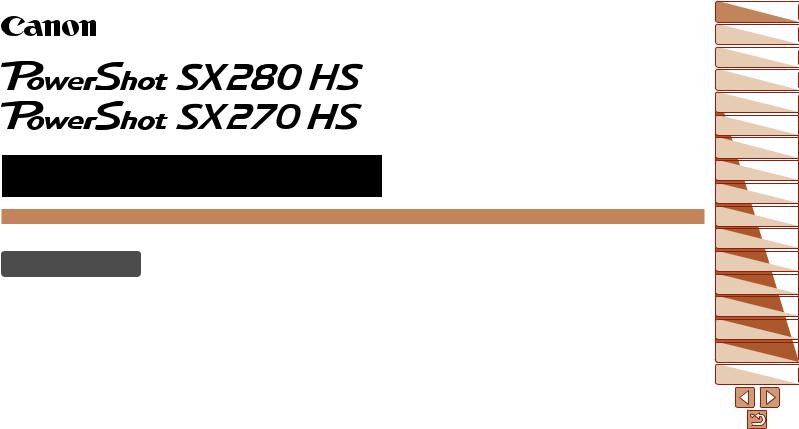
Camera User Guide
ENGLISH
•Make sure you read this guide, including the “Safety Precautions” section, before using the camera.
•Reading this guide will help you learn to use the camera properly.
•Store this guide safely so that you can use it in the future.
•Click the buttons in the lower right to access other pages.
 : Next page
: Next page
 : Previous page
: Previous page
 : Page before you clicked a link
: Page before you clicked a link
•To jump to the beginning of a chapter, click the chapter title at right.
From chapter title pages, you can access topics by clicking their titles.
Cover
Preliminary Notes
and Legal Information
Contents: Basic
Operations
Basic Guide
Advanced Guide
1 |
Camera Basics |
2 |
Using GPS |
Function |
|
3 |
Auto Mode/ |
Hybrid Auto Mode |
|
4 |
Other Shooting |
Modes |
|
5 P Mode |
|
6 |
ModeTv, Av, and M |
7 |
Playback Mode |
8 |
Wi-Fi Functions |
9 |
Setting Menu |
10 |
Accessories |
11 |
Appendix |
Index
©CANON INC. 2013 |
CDD-E515-010 |
1 |
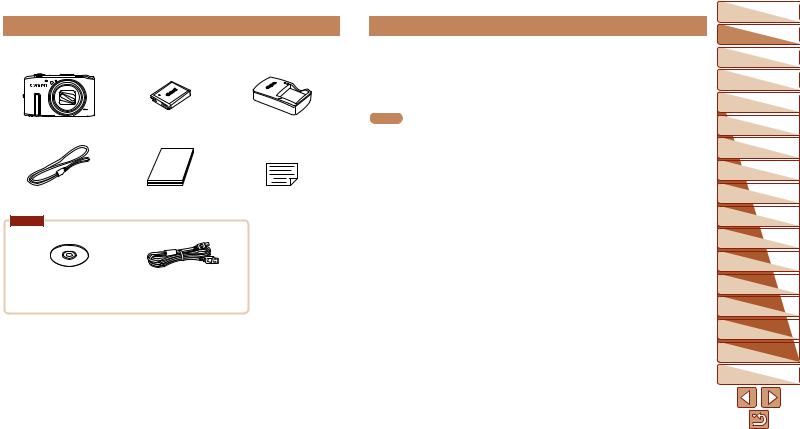
 Package Contents
Package Contents
Before use, make sure the following items are included in the package. If anything is missing, contact your camera retailer.
Camera |
Battery Pack |
Battery Charger |
|
NB-6L |
CB-2LY/CB-2LYE |
Wrist Strap |
Getting Started |
Warranty Card |
WS-DC11 |
|
|
SX280 HS |
DIGITAL CAMERA |
Interface Cable |
Solution Disk* |
IFC-400PCU |
(CD-ROM) |
|
* Contains software and PDF manuals (=21).
• A memory card is not included (=2).
 Compatible Memory Cards
Compatible Memory Cards
The following memory cards (sold separately) can be used, regardless of capacity.
•SD memory cards*
•SDHC memory cards*
•SDXC memory cards*
SX270 HS
• Eye-Fi cards
*Cards conforming to SD standards. However, not all memory cards have been verified to work with the camera.
 About Eye-Fi Cards
About Eye-Fi Cards
This product is not guaranteed to support Eye-Fi card functions (including wireless transfer). In case of an issue with an Eye-Fi card, please check with the card manufacturer.
Also note that an approval is required to use Eye-Fi cards in many countries or regions. Without approval, use of the card is not permitted. If it is unclear whether the card has been approved for use in the area, please check with the card manufacturer.
Cover
Preliminary Notes
and Legal Information
Contents: Basic
Operations
Basic Guide
Advanced Guide
1 |
Camera Basics |
2 |
Using GPS |
Function |
|
3 |
Auto Mode/ |
Hybrid Auto Mode |
|
4 |
Other Shooting |
Modes |
|
5 P Mode |
|
6 |
ModeTv, Av, and M |
7 |
Playback Mode |
8 |
Wi-Fi Functions |
9 |
Setting Menu |
10 |
Accessories |
11 |
Appendix |
Index
2

 Preliminary Notes and Legal
Preliminary Notes and Legal
Information
•Take and review some test shots initially to make sure the images were recorded correctly. Please note that Canon Inc., its subsidiaries and affiliates, and its distributors are not liable for any consequential damages arising from any malfunction of a camera or accessory, including memory cards, that result in the failure of an image to be recorded or to be recorded in a way that is machine readable.
•Images recorded by the camera are intended for personal use. Refrain from unauthorized recording that infringes on copyright law, and note that even for personal use, photography may contravene copyright or other legal rights at some performances or exhibitions, or in some commercial settings.
•The camera warranty is valid only in the area of purchase. In case of camera problems while abroad, return to the area of purchase before contacting a Canon Customer Support Help Desk.
•Although the LCD monitor is produced under extremely high-precision manufacturing conditions and more than 99.99% of the pixels meet design specifications, in rare cases some pixels may be defective or may appear as red or black dots. This does not indicate camera damage or affect recorded images.
•The LCD monitor may be covered with a thin plastic film for protection against scratches during shipment. If covered, remove the film before using the camera.
•When the camera is used over an extended period, it may become warm. This does not indicate damage.
Cover
Preliminary Notes
and Legal Information
Contents: Basic
Operations
Basic Guide
Advanced Guide
1 |
Camera Basics |
2 |
Using GPS |
Function |
|
3 |
Auto Mode/ |
Hybrid Auto Mode |
|
4 |
Other Shooting |
Modes |
|
5 P Mode |
|
6 |
ModeTv, Av, and M |
7 |
Playback Mode |
8 |
Wi-Fi Functions |
9 |
Setting Menu |
10 |
Accessories |
11 |
Appendix |
Index
3

 Part Names and Conventions in This
Part Names and Conventions in This
Guide
Microphone |
SX280 HS |
|
Lamp |
Wi-Fi antenna area |
|
Lens |
SX280 HS |
|
Zoom lever |
GPS antenna |
|
Shooting: <i(telephoto)> / |
Flash |
|
<j(wide angle)> |
Speaker |
|
Playback: <k(magnify)> / |
Tripod socket |
|
<g(index)> |
DC coupler terminal cover |
|
Power button |
Memory card/battery cover |
|
Shutter button |
Strap mount |
|
•Shooting modes and on-screen icons and text are indicated in brackets.
• : Important information you should know
: Important information you should know
• : Notes and tips for expert camera use
: Notes and tips for expert camera use
•=xx: Pages with related information (in this example, “xx” represents a page number)
•Instructions in this guide apply to the camera under default settings.
•For convenience, all supported memory cards are simply referred to as the “memory card”.
•The tabs shown above titles indicate whether the function is used for still images, movies, or both.
Still Images :Indicates that the function is used when shooting or viewing still images.
Movies :Indicates that the function is used when shooting or viewing movies.
Cover
Preliminary Notes
and Legal Information
Contents: Basic
Operations
Basic Guide
Advanced Guide
1 |
Camera Basics |
2 |
Using GPS |
Function |
|
3 |
Auto Mode/ |
Hybrid Auto Mode |
|
4 |
Other Shooting |
Modes |
|
5 P Mode |
|
6 |
ModeTv, Av, and M |
7 |
Playback Mode |
8 |
Wi-Fi Functions |
9 |
Setting Menu |
10 |
Accessories |
11 |
Appendix |
Index
4
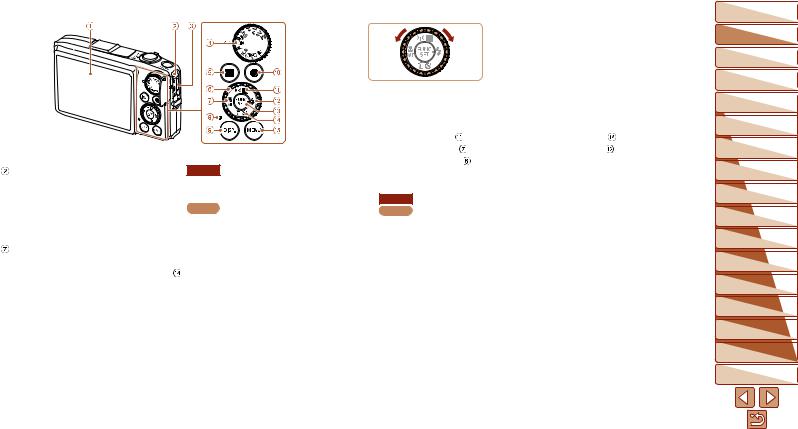
 Screen (LCD monitor)
Screen (LCD monitor)
AV OUT (Audio/video output) / DIGITAL terminal
 HDMITM terminal
HDMITM terminal
 Mode dial
Mode dial
 <1(Playback)> button
<1(Playback)> button
 Control dial
Control dial
<e(Macro)> / <f(Manual focus)> / Left button
 Indicator
Indicator
 <l(Display)> button
<l(Display)> button
 Movie button
Movie button

 SX280 HS
SX280 HS
<b(Exposure compensation)> / <

 (Wi-Fi)> / Up button
(Wi-Fi)> / Up button
SX270 HS
<b(Exposure compensation)> / Up button
 <h(Flash)> / Right button
<h(Flash)> / Right button
 FUNC./SET button
FUNC./SET button
<Q(Self-timer)> / <a(Singleimage erase)> / Down button
 <n> button
<n> button
zzTurning the control dial is one way to choose setting items, switch images, and perform other operations. Most of these operations are also possible with the <o><p><q><r> buttons.
•In this guide, icons are used to represent the corresponding camera buttons and dials on which they appear or which they resemble.
•The following camera buttons and controls are represented by icons.
<o> Up button |
on back |
<p> Down button |
on back |
<q> Left button |
on back |
<r> Right button |
on back |
<5> Control dial |
on back |
|
|
•The following icons are used to indicate functions that differ depending on the camera model:
SX280 HS : Functions and precautions for the PowerShot SX280 HS only
SX270 HS : Functions and precautions for the PowerShot SX270 HS only
•This guide uses PowerShot SX280 HS illustrations and screenshots for all explanations.
Cover
Preliminary Notes
and Legal Information
Contents: Basic
Operations
Basic Guide
Advanced Guide
1 |
Camera Basics |
2 |
Using GPS |
Function |
|
3 |
Auto Mode/ |
Hybrid Auto Mode |
|
4 |
Other Shooting |
Modes |
|
5 P Mode |
|
6 |
ModeTv, Av, and M |
7 |
Playback Mode |
8 |
Wi-Fi Functions |
9 |
Setting Menu |
10 |
Accessories |
11 |
Appendix |
Index
5

 Table of Contents
Table of Contents
Package Contents.......................... |
2 |
Compatible Memory Cards............. |
2 |
Preliminary Notes and Legal |
|
Information...................................... |
3 |
Part Names and Conventions |
|
in This Guide.................................. |
4 |
Table of Contents........................... |
6 |
Contents: Basic Operations............ |
8 |
Safety Precautions......................... |
9 |
Basic Guide.................... |
12 |
Initial Preparations........................ |
13 |
Trying the Camera Out................. |
18 |
Software, PDF Manuals |
|
(on the included CD-ROM)........... |
21 |
Downloadable Software............... |
26 |
System Map.................................. |
30 |
Advanced Guide............. |
31 |
1 Camera Basics..................... |
31 |
On/Off........................................... |
32 |
Shutter Button.............................. |
33 |
Shooting Modes........................... |
33 |
Shooting Display Options............. |
34 |
FUNC. Menu................................. |
34 |
MENU Menu................................. |
35 |
|
Indicator Display........................... |
36 |
|
Clock............................................. |
37 |
2 |
Using GPS Function............ |
38 |
|
Using GPS Function..................... |
39 |
3 |
Auto Mode/ |
|
|
Hybrid Auto Mode................ |
46 |
|
Shooting With Camera-Determined |
|
|
Settings......................................... |
47 |
|
Common, Convenient Features... |
53 |
|
Using Face ID............................... |
57 |
|
Image Customization Features.... |
63 |
|
Helpful Shooting Features............ |
65 |
|
Customizing Camera |
|
|
Operation...................................... |
66 |
4 |
Other Shooting Modes........ |
68 |
|
Brightness/Color Customization |
|
|
(Live View Control)....................... |
69 |
|
Discreet Mode.............................. |
69 |
|
Moving Subjects (Sports)............. |
70 |
|
Specific Scenes............................ |
71 |
|
Image Effects (Creative Filters).... |
73 |
|
Special Modes for Other |
|
|
Purposes...................................... |
77 |
|
Shooting Various Movies.............. |
80 |
5 |
P Mode.................................. |
82 |
|
Shooting in Program AE |
|
|
([P] Mode)..................................... |
83 |
|
Image Brightness |
|
|
(Exposure Compensation)............ |
83 |
|
Color and Continuous Shooting... |
86 |
|
Shooting Range and Focusing..... |
89 |
|
Flash............................................. |
93 |
|
Other Settings.............................. |
95 |
6 Tv, Av, and M Mode.............. |
96 |
|
|
Specific Shutter Speeds |
|
|
([Tv] Mode)................................... |
97 |
|
Specific Aperture Values |
|
|
([Av] Mode)................................... |
97 |
|
Specific Shutter Speeds and |
|
|
Aperture Values ([M] Mode).......... |
98 |
7 |
Playback Mode................... |
100 |
|
Viewing....................................... |
101 |
|
Browsing and Filtering |
|
|
Images........................................ |
105 |
|
Editing Face ID Information........ |
107 |
|
Image Viewing Options............... |
108 |
|
Protecting Images...................... |
111 |
|
Erasing Images.......................... |
113 |
|
Rotating Images......................... |
115 |
|
Tagging Images as Favorites..... |
116 |
|
Editing Still Images..................... |
117 |
|
Editing Movies............................ |
121 |
8 |
Wi-Fi Functions.................. |
122 |
|
What You Can Do With Wi-Fi..... |
123 |
|
Using Wi-Fi to Send Images From |
|
|
the Camera................................. |
124 |
|
Wi-Fi (Wireless LAN) |
|
|
Precautions................................ |
124 |
|
Security Precautions.................. |
125 |
|
Glossary..................................... |
126 |
|
Registering a Camera Nickname |
|
|
(First time only)........................... |
126 |
|
Connecting to Web Services...... |
127 |
|
Connecting to a Smartphone...... |
130 |
|
Connecting to Another |
|
|
Camera....................................... |
133 |
|
Connecting to a Computer......... |
134 |
|
Connecting to a Printer............... |
139 |
|
Sending Images......................... |
141 |
|
Sending Images to a Computer via |
|
|
CANON iMAGE GATEWAY........ |
143 |
|
Geotagging Images on the |
|
|
Camera....................................... |
144 |
|
Editing or Erasing Wi-Fi |
|
|
Settings....................................... |
145 |
9 |
Setting Menu...................... |
148 |
|
Adjusting Basic Camera |
|
|
Functions.................................... |
149 |
10 Accessories........................ |
156 |
|
|
Optional Accessories.................. |
157 |
|
Using Optional Accessories........ |
158 |
Cover
Preliminary Notes
and Legal Information
Contents: Basic
Operations
Basic Guide
Advanced Guide
1 |
Camera Basics |
2 |
Using GPS |
Function |
|
3 |
Auto Mode/ |
Hybrid Auto Mode |
|
4 |
Other Shooting |
Modes |
|
5 P Mode |
|
6 |
ModeTv, Av, and M |
7 |
Playback Mode |
8 |
Wi-Fi Functions |
9 |
Setting Menu |
10 |
Accessories |
11 |
Appendix |
Index
6

Printing Images.......................... |
162 |
Using an Eye-Fi Card................. |
170 |
11 Appendix............................. |
172 |
Troubleshooting.......................... |
173 |
On-Screen Messages................. |
176 |
On-Screen Information............... |
179 |
Functions and Menu Tables........ |
181 |
Handling Precautions................. |
189 |
Specifications............................. |
190 |
Index........................................... |
194 |
Cover
Preliminary Notes
and Legal Information
Contents: Basic
Operations
Basic Guide
Advanced Guide
1 |
Camera Basics |
2 |
Using GPS |
Function |
|
3 |
Auto Mode/ |
Hybrid Auto Mode |
|
4 |
Other Shooting |
Modes |
|
5 P Mode |
|
6 |
ModeTv, Av, and M |
7 |
Playback Mode |
8 |
Wi-Fi Functions |
9 |
Setting Menu |
10 |
Accessories |
11 |
Appendix |
Index
7
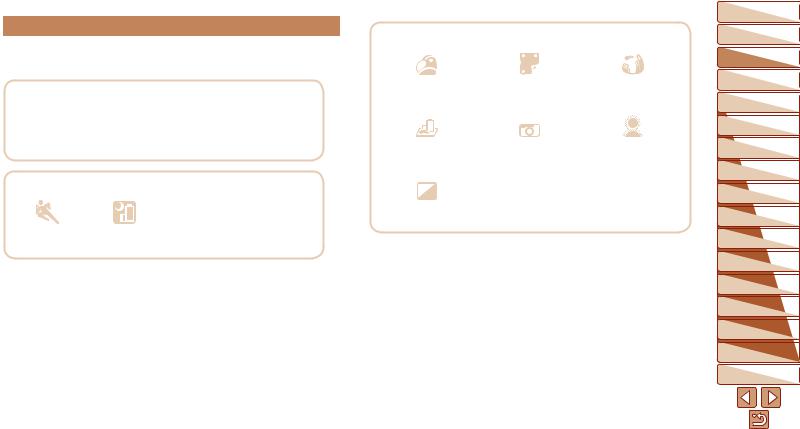
 Contents: Basic Operations
Contents: Basic Operations
4 Shoot
zzUse camera-determined settings (Auto Mode, Hybrid Auto Mode)...... 47
Shooting people well |
|
|
|
|
I |
P |
|
|
Portraits |
Against Snow |
|
|
(=71) |
(=71) |
|
Matching specific scenes |
|
|
|
|
|
S |
t |
Sports |
Night Scenes |
Under Water |
Fireworks |
(=70) |
(=71) |
(=71) |
(=72) |
Applying special effects
Vivid Colors |
Poster Effect |
Fish-Eye Effect |
|
(=73) |
(=74) |
(=74) |
|
Miniature Effect |
Toy Camera Effect |
Soft Focus |
|
(=74) |
(=75) |
(=76) |
|
Monochrome |
|
|
|
(=76) |
|
|
|
zzWhere sound and flash are not allowed (Discreet Mode)..................... |
69 |
||
zzWhile adjusting image settings (Live View Control).............................. |
69 |
||
zzFocus on faces......................................................................... |
|
|
47, 71, 91 |
zzWithout using the flash (Flash Off)....................................................... |
|
56 |
|
zzInclude yourself in the shot (Self-Timer)......................................... |
|
54, 78 |
|
zzAdd a date stamp................................................................................. |
|
|
56 |
zzUse Face ID.................................................................................. |
|
|
57, 104 |
Cover
Preliminary Notes
and Legal Information
Contents: Basic
Operations
Basic Guide
Advanced Guide
1 |
Camera Basics |
2 |
Using GPS |
Function |
|
3 |
Auto Mode/ |
Hybrid Auto Mode |
|
4 |
Other Shooting |
Modes |
|
5 P Mode |
|
6 |
ModeTv, Av, and M |
7 |
Playback Mode |
8 |
Wi-Fi Functions |
9 |
Setting Menu |
10 |
Accessories |
11 |
Appendix |
Index
8

1 View |
|
zzView images (Playback Mode)........................................................... |
101 |
zzAutomatic playback (Slideshow)......................................................... |
109 |
zzOn a TV.............................................................................................. |
158 |
zzOn a computer...................................................................................... |
22 |
zzBrowse through images quickly.......................................................... |
105 |
zzErase images....................................................................................... |
113 |
E Shoot/View Movies |
|
zzShoot movies.................................................................................. |
47, 80 |
zzView movies (Playback Mode)............................................................ |
101 |
zzFast-moving subjects, slow-motion playback....................................... |
81 |
c Print |
|
zzPrint pictures....................................................................................... |
162 |
Save |
|
zzSave images to a computer.................................................................. |
24 |
SX280 HS |
|
Use Wi-Fi Functions |
|
zzSend images to a smartphone............................................................ |
130 |
zzShare images online........................................................................... |
127 |
zzSend images to a computer................................................................ |
134 |
 Safety Precautions
Safety Precautions
•Before using the product, please ensure that you read the safety precautions described below. Always ensure that the product is used correctly.
•The safety precautions noted on the following pages are intended to prevent injuries to yourself and other persons, or damage to the equipment.
•Be sure to also check the guides included with any separately sold accessories you use.
 Warning Denotes the possibility of serious injury or death.
Warning Denotes the possibility of serious injury or death.
•Do not trigger the flash in close proximity to people’s eyes.
Exposure to the intense light produced by the flash could damage eyesight.
In particular, remain at least 1 meter (39 inches) away from infants when using the flash.
•Store this equipment out of the reach of children and infants.
Strap: Putting the strap around a child’s neck could result in asphyxiation.
•Use only recommended power sources.
•Do not attempt to disassemble, alter or apply heat to the product.
•Avoid dropping or subjecting the product to severe impacts.
•To avoid the risk of injury, do not touch the interior of the product if it has been dropped or otherwise damaged.
•Stop using the product immediately if it emits smoke, a strange smell, or otherwise behaves abnormally.
•Do not use organic solvents such as alcohol, benzine, or thinner to clean the product.
•Do not let the product come into contact with water (e.g. sea water) or other liquids.
Cover
Preliminary Notes
and Legal Information
Contents: Basic
Operations
Basic Guide
Advanced Guide
1 |
Camera Basics |
2 |
Using GPS |
Function |
|
3 |
Auto Mode/ |
Hybrid Auto Mode |
|
4 |
Other Shooting |
Modes |
|
5 P Mode |
|
6 |
ModeTv, Av, and M |
7 |
Playback Mode |
8 |
Wi-Fi Functions |
9 |
Setting Menu |
10 |
Accessories |
11 |
Appendix |
Index
9

•Do not allow liquids or foreign objects to enter the camera.
This could result in electrical shock or fire.
If liquids or foreign objects come into contact with the camera interior, immediately turn the camera off and remove the battery.
If the battery charger becomes wet, unplug it from the outlet and consult your camera retailer or a Canon Customer Support Help Desk.
•Use only the recommended battery.
•Do not place the battery near or in direct flame.
•Unplug the power cord periodically, and using a dry cloth, wipe away any dust and dirt that has collected on the plug, the exterior of the power outlet, and the surrounding area.
•Do not handle the power cord with wet hands.
•Do not use the equipment in a manner that exceeds the rated capacity of the electrical outlet or wiring accessories. Do not use if the power cord or plug are damaged, or not fully plugged into the outlet.
•Do not allow dirt or metal objects (such as pins or keys) to contact the terminals or plug.
The battery may explode or leak, resulting in electrical shock or fire. This could cause injury and damage the surroundings. In the event that a battery leaks and the battery electrolyte contacts eyes, mouth, skin or clothing, immediately flush with water.
• Turn the camera off in places where camera use is prohibited.
The electromagnetic waves emitted by the camera may interfere with the operation of electronic instruments and other devices. Exercise adequate caution when using the camera in places where use of electronic devices is restricted, such as inside airplanes and medical facilities.
SX280 HS
•Do not play the supplied CD-ROM(s) in any CD player that does not support data CD-ROMs.
It is possible to suffer hearing loss from listening with headphones to the loud sounds of a CD-ROM played on an audio CD player (music player). Additionally, this could damage the speakers.
 Caution Denotes the possibility of injury.
Caution Denotes the possibility of injury.
•When holding the camera by the strap, be careful not to bang it, subject it to strong impacts or shocks, or let it get caught on other objects.
•Be careful not to bump or push strongly on the lens.
This could lead to injury or damage the camera.
• Be careful not to subject the screen to strong impacts.
If the screen cracks, injury may result from the broken fragments.
•When using the flash, be careful not to cover it with your fingers or clothing.
This could result in burns or damage to the flash.
•Avoid using, placing or storing the product in the following places:
-Places subject to direct sunlight
-Places subject to temperatures above 40 °C (104 °F)
-Humid or dusty areas
These could cause leakage, overheating or an explosion of the battery, resulting in electrical shock, fire, burns or other injuries.
High temperatures may cause deformation of the camera or battery charger casing.
•The slideshow transition effects may cause discomfort when viewed for prolonged periods.
•Take care not to pinch your finger when the flash lowers.
This could result in injury.
Cover
Preliminary Notes
and Legal Information
Contents: Basic
Operations
Basic Guide
Advanced Guide
1 |
Camera Basics |
2 |
Using GPS |
Function |
|
3 |
Auto Mode/ |
Hybrid Auto Mode |
|
4 |
Other Shooting |
Modes |
|
5 P Mode |
|
6 |
ModeTv, Av, and M |
7 |
Playback Mode |
8 |
Wi-Fi Functions |
9 |
Setting Menu |
10 |
Accessories |
11 |
Appendix |
Index
10

Caution Denotes the possibility of damage to the equipment.
•Do not aim the camera at bright light sources (such as the sun on a clear day).
Doing so may damage the image sensor.
•When using the camera on a beach or at a windy location, be careful not to allow dust or sand to enter the camera.
•Do not push down on the flash, or pry it open.
This may cause the product to malfunction.
•In regular use, small amounts of smoke may be emitted from the flash.
This is due to the high intensity of the flash burning dust and foreign materials stuck to the front of the unit. Please use a cotton swab to remove dirt, dust or other foreign matter from the flash to prevent heat build-up and damage to the unit.
•Remove and store the battery when you are not using the camera.
If the battery is left inside the camera, damage caused by leakage may occur.
•Before you discard the battery, cover the terminals with tape or other insulators.
Contacting other metal materials may lead to fire or explosions.
•Unplug the battery charger from the power outlet after charging is complete, or when you are not using it.
•Do not place anything, such as cloth, on top of the battery charger while it is charging.
Leaving the unit plugged in for a long period of time may cause it to overheat and distort, resulting in fire.
• Do not place the battery near pets.
Pets biting the battery could cause leakage, overheating or explosion, resulting in fire or damage.
•Do not sit down with the camera in your pocket.
Doing so may cause malfunctions or damage the screen.
•When putting the camera in your bag, ensure that hard objects do not come into contact with the screen.
•Do not attach any hard objects to the camera.
Doing so may cause malfunctions or damage the screen.
Cover
Preliminary Notes
and Legal Information
Contents: Basic
Operations
Basic Guide
Advanced Guide
1 |
Camera Basics |
2 |
Using GPS |
Function |
|
3 |
Auto Mode/ |
Hybrid Auto Mode |
|
4 |
Other Shooting |
Modes |
|
5 P Mode |
|
6 |
ModeTv, Av, and M |
7 |
Playback Mode |
8 |
Wi-Fi Functions |
9 |
Setting Menu |
10 |
Accessories |
11 |
Appendix |
Index
11

Basic Guide
Gives basic instructions, from initial preparations to |
|
4 shooting, playback, and saving on a computer |
|
Initial Preparations................... |
13 |
Trying the Camera Out............. |
18 |
Software, PDF Manuals |
|
(on the included CD-ROM)...... |
21 |
Downloadable Software........... |
26 |
System Map............................... |
30 |
Cover
Preliminary Notes
and Legal Information
Contents: Basic
Operations
Basic Guide
Advanced Guide
1 |
Camera Basics |
2 |
Using GPS |
Function |
|
3 |
Auto Mode/ |
Hybrid Auto Mode |
|
4 |
Other Shooting |
Modes |
|
5 P Mode |
|
6 |
ModeTv, Av, and M |
7 |
Playback Mode |
8 |
Wi-Fi Functions |
9 |
Setting Menu |
10 |
Accessories |
11 |
Appendix |
Index
12

 Initial Preparations
Initial Preparations
Prepare for shooting as follows.
 Attaching the Strap
Attaching the Strap
Attach the strap.
zzThread the end of the strap through the strap hole ( ), and then pull the other end of the strap through the loop on the threaded end (
), and then pull the other end of the strap through the loop on the threaded end ( ).
).
 Holding the Camera
Holding the Camera
zzPlace the strap around your wrist.
zzWhen shooting, keep your arms close to your body and hold the camera securely to prevent it from moving. If the flash is up, do not rest your fingers on it.
 Charging the Battery
Charging the Battery
Before use, charge the battery with the included charger. Be sure to charge the battery initially, because the camera is not sold with the battery charged.
1 Insert the battery.
zzAfter aligning the marks on the battery
|
and charger, insert the battery by pushing |
|
it in ( ) and down ( ). |
|
2 Charge the battery. |
|
zzCB 2LY: Flip out the plug ( ) and plug |
|
the charger into a power outlet ( ). |
CB-2LY |
zzCB-2LYE: Plug the power cord into the |
charger, then plug the other end into a |
|
|
power outlet. |
|
XXThe charging lamp turns orange and |
|
charging begins. |
|
XXWhen charging is finished, the lamp turns |
CB-2LYE |
green. |
|
|
|
3 Remove the battery. |
|
zzAfter unplugging the battery charger, |
|
remove the battery by pushing it in ( ) |
|
and up ( ). |
Cover
Preliminary Notes
and Legal Information
Contents: Basic
Operations
Basic Guide
Advanced Guide
1 |
Camera Basics |
2 |
Using GPS |
Function |
|
3 |
Auto Mode/ |
Hybrid Auto Mode |
|
4 |
Other Shooting |
Modes |
|
5 P Mode |
|
6 |
ModeTv, Av, and M |
7 |
Playback Mode |
8 |
Wi-Fi Functions |
9 |
Setting Menu |
10 |
Accessories |
11 |
Appendix |
Index
13
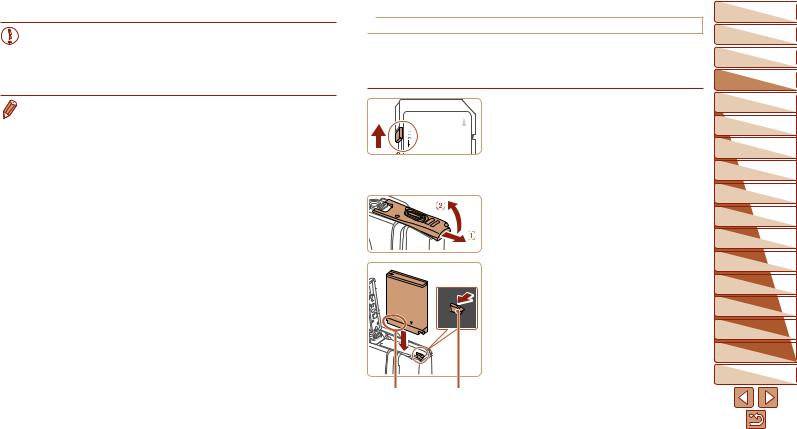
•To protect the battery and keep it in optimal condition, do not charge it continuously for more than 24 hours.
•For battery chargers that use a power cord, do not attach the charger or cord to other objects. Doing so could result in malfunction or damage to the product.
•For details on charging time and the number of shots and recording time possible with a fully charged battery, see “Number of Shots/Recording Time, Playback Time” (=190).
•Charged batteries gradually lose their charge, even when they are not used. Charge the battery on (or immediately before) the day of use.
•The charger can be used in areas with 100 – 240 V AC power (50/60 Hz). For power outlets in a different format, use a commercially available adapter for the plug. Never use an electrical transformer designed for traveling, which may damage the battery.
 Inserting the Battery and Memory Card
Inserting the Battery and Memory Card
Insert the included battery and a memory card (sold separately).
Note that before using a new memory card (or a memory card formatted in another device), you should format the memory card with this camera (=152).
1 Check the card’s write-protect tab.
zzRecording is not possible on memory cards with a write-protect tab when the tab is in the locked (downward) position. Slide the tab up until it clicks into the unlocked position.
Terminals |
Battery |
|
Lock |
2 Open the cover.
zzSlide the cover ( ) and open it (
) and open it ( ).
).
3 Insert the battery.
zzWhile pressing the battery lock in the direction of the arrow, insert the battery as shown and push it in until it clicks into the locked position.
zzIf you insert the battery facing the wrong way, it cannot be locked into the correct position. Always confirm that the battery is facing the right way and locks when inserted.
Cover
Preliminary Notes
and Legal Information
Contents: Basic
Operations
Basic Guide
Advanced Guide
1 |
Camera Basics |
2 |
Using GPS |
Function |
|
3 |
Auto Mode/ |
Hybrid Auto Mode |
|
4 |
Other Shooting |
Modes |
|
5 P Mode |
|
6 |
ModeTv, Av, and M |
7 |
Playback Mode |
8 |
Wi-Fi Functions |
9 |
Setting Menu |
10 |
Accessories |
11 |
Appendix |
Index
14
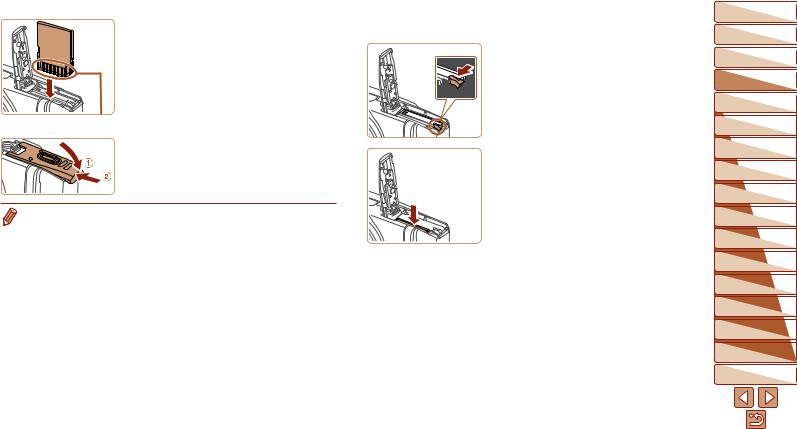
4 Insert the memory card.
zzInsert the memory card facing as shown
until it clicks into the locked position.
zzMake sure the memory card is facing the
right way when you insert it. Inserting
memory cards facing the wrong way may
damage the camera.
Terminals
5 Close the cover.
zzLower the cover ( ) and hold it down as you slide it, until it clicks into the closed position (
) and hold it down as you slide it, until it clicks into the closed position ( ).
).
• For guidelines on how many shots or hours of recording can be saved on one memory card, see “Number of 4:3 Shots per Memory Card” (=191).
 Removing the Battery and Memory Card
Removing the Battery and Memory Card
Remove the battery.
zzOpen the cover and press the battery
lock in the direction of the arrow. XXThe battery will pop up.
Remove the memory card. zzPush the memory card in until it clicks,
and then slowly release it. XXThe memory card will pop up.
Cover
Preliminary Notes
and Legal Information
Contents: Basic
Operations
Basic Guide
Advanced Guide
1 |
Camera Basics |
2 |
Using GPS |
Function |
|
3 |
Auto Mode/ |
Hybrid Auto Mode |
|
4 |
Other Shooting |
Modes |
|
5 P Mode |
|
6 |
ModeTv, Av, and M |
7 |
Playback Mode |
8 |
Wi-Fi Functions |
9 |
Setting Menu |
10 |
Accessories |
11 |
Appendix |
Index
15

 Setting the Date and Time
Setting the Date and Time
Set the current date and time correctly as follows if the [Date/Time] screen is displayed when you turn the camera on. Information you specify this way is recorded in image properties when you shoot, and it is used when you manage images by shooting date or print images showing the date.
You can also add a date stamp to shots, if you wish (=56).
1 Turn the camera on. zzPress the power button.
XXThe [Date/Time] screen is displayed.
2 Set the date and time.
zzPress the <q><r> buttons to choose an option.
zzPress the <o><p> buttons or turn the <5> dial to specify the date and time.
zzWhen finished, press the <m> button.
3 Set the home time zone. zzPress the <q><r> buttons or turn the
<5> dial to choose your home time zone.
4 Finish the setup process. zzPress the <m> button when finished.
After a confirmation message, the setting screen is no longer displayed.
zzTo turn off the camera, press the power button.
• Unless you set the date, time, and home time zone, the [Date/Time] screen will be displayed each time you turn the camera on. Specify the correct information.
• To set daylight saving time (1 hour ahead), choose [ ] in step 2 and then choose [
] in step 2 and then choose [ ] by pressing the <o><p> buttons or turning the <5> dial.
] by pressing the <o><p> buttons or turning the <5> dial.
 Changing the Date and Time
Changing the Date and Time
Adjust the date and time as follows.
1 Access the camera menu. zzPress the <n> button.
Cover
Preliminary Notes
and Legal Information
Contents: Basic
Operations
Basic Guide
Advanced Guide
1 |
Camera Basics |
2 |
Using GPS |
Function |
|
3 |
Auto Mode/ |
Hybrid Auto Mode |
|
4 |
Other Shooting |
Modes |
|
5 P Mode |
|
6 |
ModeTv, Av, and M |
7 |
Playback Mode |
8 |
Wi-Fi Functions |
9 |
Setting Menu |
10 |
Accessories |
11 |
Appendix |
Index
16
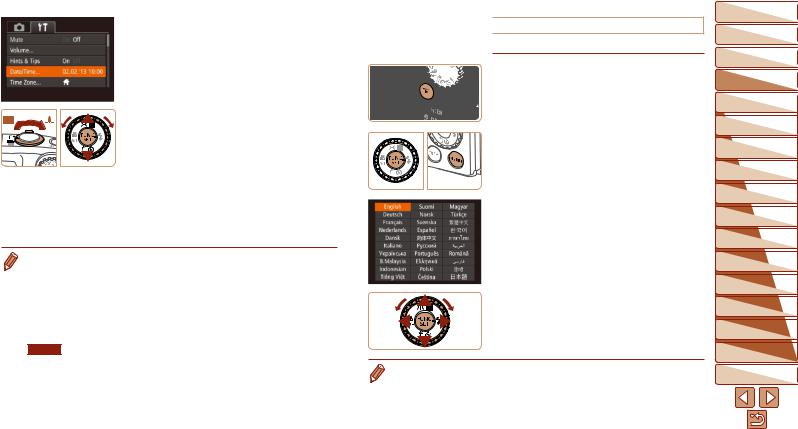
2 Choose [Date/Time].
zzMove the zoom lever to choose the [3] tab.
zzPress the <o><p> buttons or turn the <5> dial to choose [Date/Time], and then press the <m> button.
3 Change the date and time. zzFollow step 2 on =16 to adjust the
settings.
zzPress the <n> button to close the menu.
•Date/time settings can be retained for about 3 weeks by the camera’s built-in date/time battery (backup battery) after the battery pack is removed.
•The date/time battery will be charged in about 4 hours once you insert a charged battery or connect the camera to an AC adapter kit (sold separately, =157), even if the camera is left off.
•Once the date/time battery is depleted, the [Date/Time] screen will be displayed when you turn the camera on. Follow the steps on =16 to set the date and time.
SX280 HS
• Automatic date and time updating is possible using GPS (=44).
 Display Language
Display Language
Change the display language as needed.
1 Enter Playback mode. zzPress the <1> button.
2 Access the setting screen. zzPress and hold the <m> button, and
then immediately press the <n> button.
3 Set the display language. zzPress the <o><p><q><r> buttons or
turn the <5> dial to choose a language, and then press the <m> button.
XXOnce the display language has been set, the setting screen is no longer displayed.
• The current time is displayed if you wait too long in step 2 after pressing the <m> button before you press the <n> button. In this case, press the <m> button to dismiss the time display and repeat step 2.
•You can also change the display language by pressing the <n> button and choosing [Language  ] on the [3] tab.
] on the [3] tab.
Cover
Preliminary Notes
and Legal Information
Contents: Basic
Operations
Basic Guide
Advanced Guide
1 |
Camera Basics |
2 |
Using GPS |
Function |
|
3 |
Auto Mode/ |
Hybrid Auto Mode |
|
4 |
Other Shooting |
Modes |
|
5 P Mode |
|
6 |
ModeTv, Av, and M |
7 |
Playback Mode |
8 |
Wi-Fi Functions |
9 |
Setting Menu |
10 |
Accessories |
11 |
Appendix |
Index
17
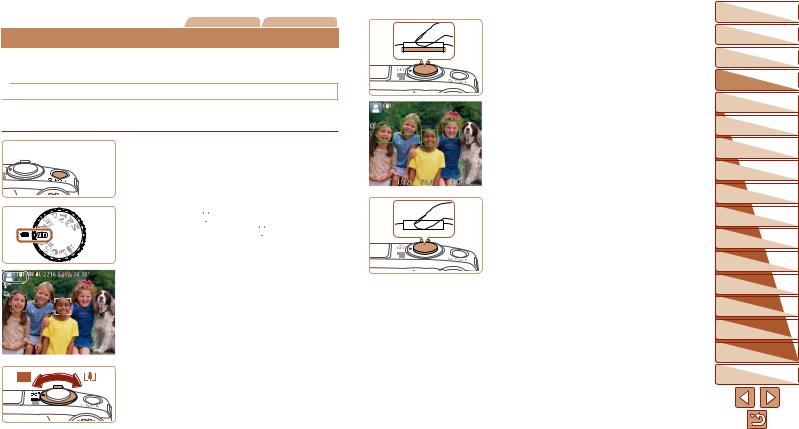
Still Images |
Movies |
 Trying the Camera Out
Trying the Camera Out
Follow these instructions to turn the camera on, shoot still images or movies, and then view them.
 Shooting (Smart Auto)
Shooting (Smart Auto)
For fully automatic selection of the optimal settings for specific scenes, simply let the camera determine the subject and shooting conditions.
1 Turn the camera on. zzPress the power button.
XXThe startup screen is displayed.
2 Enter [
 ] mode. zzSet the mode dial to [
] mode. zzSet the mode dial to [
 ].
].
zzAim the camera at the subject. The camera will make a slight clicking noise as it determines the scene.
XXIcons representing the scene and image stabilization mode are displayed in the upper left of the screen.
XXFrames displayed around any detected subjects indicate that they are in focus.
3 Compose the shot.
zzTo zoom in and enlarge the subject, move the zoom lever toward <i> (telephoto), and to zoom away from the subject, move it toward <j> (wide angle).
4 Shoot.
Shooting Still Images
 Focus.
Focus.
zzPress the shutter button lightly, halfway down. The camera beeps twice after focusing, and AF frames are displayed to indicate image areas in focus.
XXThe flash automatically rises in low-light conditions.
 Shoot.
Shoot.
zzPress the shutter button all the way down.
XXAs the camera shoots, a shutter sound is played, and in low-light conditions when the flash is up, it fires automatically.
zzKeep the camera still until the shutter sound ends.
XXYour shot is only displayed until the camera is ready to shoot again.
Cover
Preliminary Notes
and Legal Information
Contents: Basic
Operations
Basic Guide
Advanced Guide
1 |
Camera Basics |
2 |
Using GPS |
Function |
|
3 |
Auto Mode/ |
Hybrid Auto Mode |
|
4 |
Other Shooting |
Modes |
|
5 P Mode |
|
6 |
ModeTv, Av, and M |
7 |
Playback Mode |
8 |
Wi-Fi Functions |
9 |
Setting Menu |
10 |
Accessories |
11 |
Appendix |
Index
18

|
Shooting Movies |
|
|
Start shooting. |
|
|
zzPress the movie button. The camera |
|
|
beeps once as recording begins, and |
|
Elapsed Time |
[ Rec] is displayed with the elapsed time. |
|
XXBlack bars are displayed on the top and |
||
|
||
|
bottom edges of the screen, and the |
|
|
subject is slightly enlarged. The black |
|
|
bars indicate image areas not recorded. |
|
|
XXFrames displayed around any detected |
|
|
faces indicate that they are in focus. |
|
|
zzOnce recording begins, take your finger |
|
|
off the movie button. |
|
|
Finish shooting. |
|
|
zzPress the movie button again to stop |
|
|
shooting. The camera beeps twice as |
|
|
recording stops. |
•You can make a short movie of the day (digest movie) just by shooting still
images. When the mode dial is set to [ ], the camera automatically records a movie clip of the scene immediately before each shot (Hybrid Auto Mode (=49)).
], the camera automatically records a movie clip of the scene immediately before each shot (Hybrid Auto Mode (=49)).
 Viewing
Viewing
After shooting images or movies, you can view them on the screen as follows.
1 Enter Playback mode. zzPress the <1> button. XXYour last shot is displayed.
2 Browse through your images. zzTo view the previous image, press
the <q> button or turn the <5> dial counterclockwise. To view the next image, press the <r> button or turn the <5> dial clockwise.
zzPress and hold the <q><r> buttons to browse through images quickly.
zzTo access Scroll Display mode, turn the <5> dial rapidly. In this mode, turn the <5> dial to browse through images.
zzTo return to single-image display, press the <m> button.
Cover
Preliminary Notes
and Legal Information
Contents: Basic
Operations
Basic Guide
Advanced Guide
1 |
Camera Basics |
2 |
Using GPS |
Function |
|
3 |
Auto Mode/ |
Hybrid Auto Mode |
|
4 |
Other Shooting |
Modes |
|
5 P Mode |
|
6 |
ModeTv, Av, and M |
7 |
Playback Mode |
8 |
Wi-Fi Functions |
9 |
Setting Menu |
10 |
Accessories |
11 |
Appendix |
Index
19
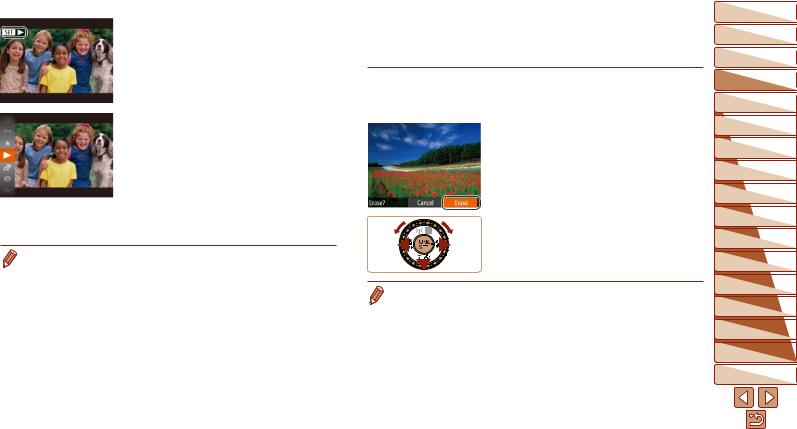
zzMovies are identified by a [ ] icon. To play movies, go to step 3.
] icon. To play movies, go to step 3.
3 Play movies.
zzPress the <m> button, choose [  ] (either press the <o><p> buttons or turn the <5> dial), and then press the <m> button again.
] (either press the <o><p> buttons or turn the <5> dial), and then press the <m> button again.
XXPlayback now begins, and after the movie is finished, [ ] is displayed.
] is displayed.
zzTo adjust the volume, press the <o><p> buttons.
•To switch to Shooting mode from Playback mode, press the shutter button halfway.
 Erasing the Images
Erasing the Images
You can choose and erase unneeded images one by one. Be careful when erasing images, because they cannot be recovered.
1 Choose an image to erase. zzPress the <q><r> buttons or turn the
<5> dial to choose an image.
2 Erase the image. zzPress the <p> button.
zzAfter [Erase?] is displayed, press the <q><r> buttons or turn the <5> dial to choose [Erase], and then press the <m> button.
XXThe current image is now erased.
zzTo cancel erasure, press the <q><r> buttons or turn the <5> dial to choose [Cancel], and then press the <m> button.
• You can also erase all images at once (=114).
Cover
Preliminary Notes
and Legal Information
Contents: Basic
Operations
Basic Guide
Advanced Guide
1 |
Camera Basics |
2 |
Using GPS |
Function |
|
3 |
Auto Mode/ |
Hybrid Auto Mode |
|
4 |
Other Shooting |
Modes |
|
5 P Mode |
|
6 |
ModeTv, Av, and M |
7 |
Playback Mode |
8 |
Wi-Fi Functions |
9 |
Setting Menu |
10 |
Accessories |
11 |
Appendix |
Index
20

SX280 HS
 Software, PDF Manuals (on the included CD-ROM)
Software, PDF Manuals (on the included CD-ROM)
The software and PDF manuals on the included DIGITAL CAMERA Solution Disk (CD-ROM) (=2) are introduced below, with instructions for installation, and saving images to a computer.
 Software
Software
After installing the software on the CD-ROM, you can do the following things on your computer.
CameraWindow
zzImport images and change camera settings
ImageBrowser EX
zzManage images: view, search, and organize zzPrint and edit images
 Auto Update Function
Auto Update Function
Using the software, you can update to the latest version, and download new functions via the Internet (some software excluded). Be sure to install the software on a computer with an Internet connection so you can use this function.
• Internet access is required to use this function, and any ISP account charges and access fees must be paid separately.
 PDF Manuals
PDF Manuals
Camera User Guide
zzRefer to this guide for a more in-depth understanding of camera operation.
Software Guide
zzRefer to this guide when using the software. The guide can be accessed from the help system of software (some software excluded).
Cover
Preliminary Notes
and Legal Information
Contents: Basic
Operations
Basic Guide
Advanced Guide
1 |
Camera Basics |
2 |
Using GPS |
Function |
|
3 |
Auto Mode/ |
Hybrid Auto Mode |
|
4 |
Other Shooting |
Modes |
|
5 P Mode |
|
6 |
ModeTv, Av, and M |
7 |
Playback Mode |
8 |
Wi-Fi Functions |
9 |
Setting Menu |
10 |
Accessories |
11 |
Appendix |
Index
21
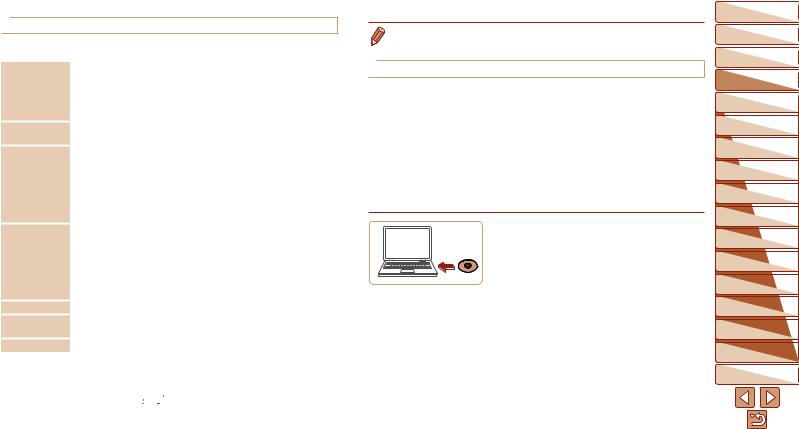
 System Requirements
System Requirements
The software can be used on the following computers. Adobe Reader is required to view the PDF manuals.
Operating
System*1
Computer
Processor
RAM
Interfaces
Free Hard Disk
Space
Display
Windows |
Macintosh |
|
Windows 8 |
Mac OS X 10.6 |
|
Windows 7 SP1 |
||
Mac OS X 10.7 |
||
Windows Vista SP2 |
||
Mac OS X 10.8*2 |
||
Windows XP SP3 |
|
Computers running one of the above operating systems (preinstalled), with an included USB port and Internet connection
|
Still images |
|
Still images |
Mac OS X 10.7 – 10.8: |
|
Core 2 Duo or higher |
||
1.6 GHz or higher |
||
Mac OS X 10.6: |
||
Movies |
||
Core Duo 1.83 GHz or higher |
||
Core i7 2.8 GHz or higher*3 |
||
|
Movies |
|
|
Core i7 2.8 GHz or higher*3 |
|
Still images |
Still images |
|
Windows 8 (64 bit), |
||
Mac OS X 10.7 – 10.8: |
||
Windows 7 (64 bit): 2 GB or more |
||
Windows 8 (32 bit), |
2 GB or more |
|
Mac OS X 10.6: 1 GB or more |
||
Windows 7 (32 bit), |
||
Movies |
||
Windows Vista: 1 GB or more |
||
2 GB or more |
||
Windows XP: 512 MB or more |
||
|
||
USB and Wi-Fi |
|
|
440 MB or more*4 |
550 MB or more*4 |
|
1024 x 768 resolution or higher |
|
*1 Wi-Fi image transfer to a computer requires Windows 8, Windows 7 SP1, Mac OS X 10.6.8, Mac OS X 10.7, or Mac OS X 10.8.2 or later.
*2 Information on computer models compatible with Mac OS X 10.8 is available on the Apple website.
*3Recommended specifications for [




 ] movie playback in ImageBrowser EX.
] movie playback in ImageBrowser EX.
*4 Includes Silverlight 5.1 (max. 100 MB). Additionally, in Windows XP, Microsoft .NET Framework 3.0 or later (max. 500 MB) must be installed. Installation may take some time, depending on computer performance.
• Check the Canon website for the latest system requirements, including supported OS versions.
 Installing the Software
Installing the Software
Windows 7 and Mac OS X 10.6 are used here for the sake of illustration. Using the software auto update function, you can update to the latest version and download new functions via the Internet (some software excluded), so be sure to install the software on a computer with an Internet connection.
What you will need: zzComputer
zzInterface cable (=2)
zzIncluded CD-ROM (DIGITAL CAMERA Solution Disk) (=2)
1Insert the CD-ROM in the computer’s CD-ROM drive.
zzInsert the included CD-ROM (DIGITAL CAMERA Solution Disk) (=2) in the computer’s CD-ROM drive.
zzOn a Macintosh computer, after inserting the disc, double-click the desktop disc icon to open it, and then double-click the [ ] icon displayed.
] icon displayed.
Cover
Preliminary Notes
and Legal Information
Contents: Basic
Operations
Basic Guide
Advanced Guide
1 |
Camera Basics |
2 |
Using GPS |
Function |
|
3 |
Auto Mode/ |
Hybrid Auto Mode |
|
4 |
Other Shooting |
Modes |
|
5 P Mode |
|
6 |
ModeTv, Av, and M |
7 |
Playback Mode |
8 |
Wi-Fi Functions |
9 |
Setting Menu |
10 |
Accessories |
11 |
Appendix |
Index
22
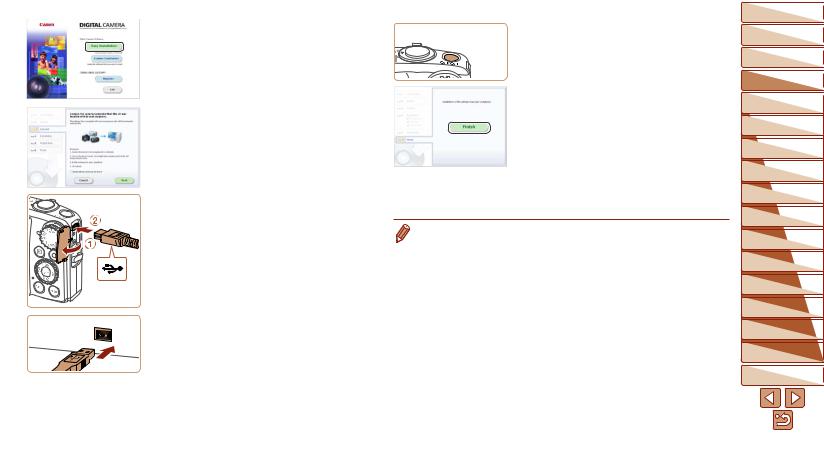
2 Begin the installation.
zzClick [Easy Installation] and follow the on-screen instructions to complete the installation process.
3When a message is displayed prompting you to connect the camera, connect it to a computer.
zzWith the camera turned off, open the cover ( ). With the smaller plug of the included interface cable (=2) in the orientation shown, insert the plug fully into the camera terminal (
). With the smaller plug of the included interface cable (=2) in the orientation shown, insert the plug fully into the camera terminal ( ).
).
zzInsert the larger plug of the interface cable in the computer’s USB port. For details about USB connections on the computer, refer to the computer user manual.
4 Install the files.
zzTurn the camera on, and follow the on-screen instructions to complete the installation process.
XXThe software will connect to the Internet to update to the latest version and download new functions. Installation may take some time, depending on computer performance and the Internet connection.
zzClick [Finish] or [Restart] on the screen after installation and remove the CDROM when the desktop is displayed.
zzTurn the camera off and disconnect the cable.
• When not connected to the Internet, there are the following limitations. - The screen in step 3 will not be displayed.
- Some functions may not be installed.
•The first time you connect the camera to the computer, drivers will be installed, so it may take a few minutes until camera images are accessible.
•If you have several cameras that were bundled with ImageBrowser EX on the included CD-ROMs, be sure to use each camera with their included CD-ROM and follow the on-screen installation instructions for each. Doing so will ensure that each camera will receive the correct updates and new functions via the auto update function.
Cover
Preliminary Notes
and Legal Information
Contents: Basic
Operations
Basic Guide
Advanced Guide
1 |
Camera Basics |
2 |
Using GPS |
Function |
|
3 |
Auto Mode/ |
Hybrid Auto Mode |
|
4 |
Other Shooting |
Modes |
|
5 P Mode |
|
6 |
ModeTv, Av, and M |
7 |
Playback Mode |
8 |
Wi-Fi Functions |
9 |
Setting Menu |
10 |
Accessories |
11 |
Appendix |
Index
23
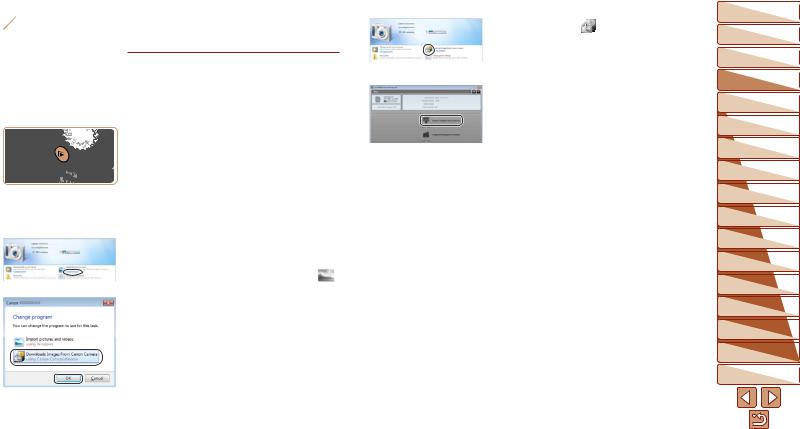
|
Saving Images to a Computer |
zzDouble click [ ]. |
|
Windows 7 and Mac OS X 10.6 are used here for the sake of illustration.
1 Connect the camera to the |
|
3 Save the images to the |
computer. |
CameraWindow |
|
|
|
|
zzFollow step 3 in “Installing the Software” |
|
computer. |
(=23) to connect the camera to a |
|
zzClick [Import Images from Camera], and |
computer. |
|
|
|
then click [Import Untransferred Images]. |
|
2 Turn the camera on to access |
|
|
|
XXImages are now saved to the Pictures |
|
CameraWindow. |
|
folder on the computer, in separate |
zzPress the <1> button to turn the camera |
|
folders named by date. |
on. |
|
zzAfter images are saved, close |
zzOn a Macintosh computer, |
|
CameraWindow, press the <1> button |
CameraWindow is displayed when a |
|
to turn the camera off, and unplug the |
connection is established between the |
|
cable. |
camera and computer. |
|
zzFor instructions on viewing images on |
zzFor Windows, follow the steps introduced |
|
a computer, refer to the Software Guide |
|
(=21). |
|
below. |
|
|
|
|
|
zzIn the screen that displays, click the [ ] |
|
|
link to modify the program. |
|
|
zzChoose [Downloads Images From Canon |
|
|
Camera using Canon CameraWindow] |
|
|
and then click [OK]. |
|
|
Cover
Preliminary Notes
and Legal Information
Contents: Basic
Operations
Basic Guide
Advanced Guide
1 |
Camera Basics |
2 |
Using GPS |
Function |
|
3 |
Auto Mode/ |
Hybrid Auto Mode |
|
4 |
Other Shooting |
Modes |
|
5 P Mode |
|
6 |
ModeTv, Av, and M |
7 |
Playback Mode |
8 |
Wi-Fi Functions |
9 |
Setting Menu |
10 |
Accessories |
11 |
Appendix |
Index
24

•In Windows 7, if the screen in step 2 is not displayed, click the [ ] icon in the taskbar.
] icon in the taskbar.
•To start CameraWindow in Windows Vista or XP, click [Downloads Images From Canon Camera using Canon CameraWindow] on the screen displayed when you turn the camera on in step 2. If CameraWindow is not displayed, click the [Start] menu and choose [All Programs] ► [Canon Utilities] ► [CameraWindow] ► [CameraWindow].
•On a Macintosh computer, if CameraWindow is not displayed after step 2, click the [CameraWindow] icon in the Dock (the bar at the bottom of the desktop).
•Although you can save images to a computer simply by connecting your camera to the computer without using the software, the following limitations apply.
-It may take a few minutes after you connect the camera to the computer until camera images are accessible.
-Images shot in vertical orientation may be saved in horizontal orientation.
-Image protection settings may be cleared from images saved to a computer.
-Some problems may occur when saving images or image information, depending on the operating system version, the software in use, or image file sizes.
-Some functions provided by the software may not be available, such as movie editing.
SX280 HS
- GPS log files (=41) may not be saved correctly.
 Using the PDF Manuals
Using the PDF Manuals
Camera User Guide
zzAccess this guide by double-clicking the desktop shortcut icon.
Software Guide
zzThe guide can be accessed from the help system of software (some software excluded).
• It may not be possible to install the PDF manuals on computers that do not meet the system requirements (=22). However, you can view the manuals on a computer that supports Adobe Reader by copying the PDF files in the
Readme folder on the CD-ROM directly to a convenient location on the computer.
Cover
Preliminary Notes
and Legal Information
Contents: Basic
Operations
Basic Guide
Advanced Guide
1 |
Camera Basics |
2 |
Using GPS |
Function |
|
3 |
Auto Mode/ |
Hybrid Auto Mode |
|
4 |
Other Shooting |
Modes |
|
5 P Mode |
|
6 |
ModeTv, Av, and M |
7 |
Playback Mode |
8 |
Wi-Fi Functions |
9 |
Setting Menu |
10 |
Accessories |
11 |
Appendix |
Index
25

SX270 HS
 Downloadable Software
Downloadable Software
The software available for download from the Canon website is introduced below, with instructions for installation and saving images to a computer.
 Software
Software
After downloading the software from the Canon website and installing it, you can do the following things on your computer.
CameraWindow
zzImport images and change camera settings
ImageBrowser EX
zzManage images: view, search, and organize zzPrint and edit images
• Internet access is required, and any ISP account charges and access fees must be paid separately.
 Software Guide
Software Guide
Refer to this guide when using the software. The guide can be accessed from the help system of software (some software excluded).
 System Requirements
System Requirements
The software can be used on the following computers.
Operating
System
Computer
Processor
RAM
Interfaces
Free Hard Disk
Space
Display
Windows |
Macintosh |
|
Windows 8 |
Mac OS X 10.6 |
|
Windows 7 SP1 |
||
Mac OS X 10.7 |
||
Windows Vista SP2 |
||
Mac OS X 10.8*1 |
||
Windows XP SP3 |
|
Computers running one of the above operating systems (preinstalled), with an included USB port and Internet connection
|
Still images |
|
Still images |
Mac OS X 10.7 – 10.8: |
|
Core 2 Duo or higher |
||
1.6 GHz or higher |
||
Mac OS X 10.6: |
||
Movies |
||
Core Duo 1.83 GHz or higher |
||
Core i7 2.8 GHz or higher*2 |
||
|
Movies |
|
|
Core i7 2.8 GHz or higher*2 |
|
Still images |
Still images |
|
Windows 8 (64 bit), |
||
Mac OS X 10.7 – 10.8: |
||
Windows 7 (64 bit): 2 GB or more |
||
Windows 8 (32 bit), |
2 GB or more |
|
Mac OS X 10.6: 1 GB or more |
||
Windows 7 (32 bit), |
||
Movies |
||
Windows Vista: 1 GB or more |
||
2 GB or more |
||
Windows XP: 512 MB or more |
||
|
||
USB |
|
|
440 MB or more*3 |
550 MB or more*3 |
|
|
|
|
1024 x 768 resolution or higher |
|
*1 Information on computer models compatible with Mac OS X 10.8 is available on the Apple website.
*2Recommended specifications for [




 ] movie playback in ImageBrowser EX.
] movie playback in ImageBrowser EX.
*3 Includes Silverlight 5.1 (max. 100 MB). Additionally, in Windows XP, Microsoft .NET Framework 3.0 or later (max. 500 MB) must be installed. Installation may take some time, depending on computer performance.
• Check the Canon website for the latest system requirements, including supported OS versions.
Cover
Preliminary Notes
and Legal Information
Contents: Basic
Operations
Basic Guide
Advanced Guide
1 |
Camera Basics |
2 |
Using GPS |
Function |
|
3 |
Auto Mode/ |
Hybrid Auto Mode |
|
4 |
Other Shooting |
Modes |
|
5 P Mode |
|
6 |
ModeTv, Av, and M |
7 |
Playback Mode |
8 |
Wi-Fi Functions |
9 |
Setting Menu |
10 |
Accessories |
11 |
Appendix |
Index
26
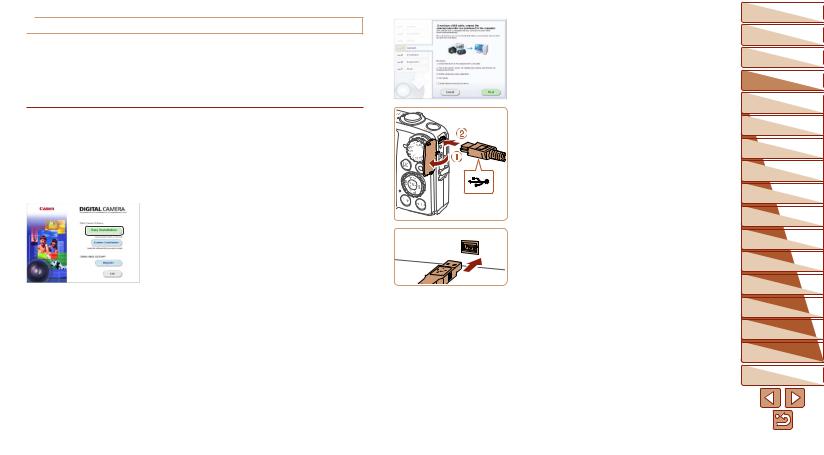
 Installing the Software
Installing the Software
Windows 7 and Mac OS X 10.6 are used here for the sake of illustration.
What you will need: zzComputer
zzUSB cable (camera end: Mini-B)
1 Download the software. zzWith a computer connected to the
Internet, access http://www.canon.com/ icpd/.
zzAccess the site for your country or region. zzDownload the software.
2 Begin the installation. zzOpen the downloaded file.
zzClick [Easy Installation] and follow the on-screen instructions to complete the installation process.
3When a message is displayed prompting you to connect the camera, connect it to a computer.
zzWith the camera turned off, open the cover ( ). With the smaller plug of the USB cable in the orientation shown, insert the plug fully into the camera terminal (
). With the smaller plug of the USB cable in the orientation shown, insert the plug fully into the camera terminal ( ).
).
zzInsert the larger plug of the USB cable in the computer’s USB port. For details about USB connections on the computer, refer to the computer user manual.
Cover
Preliminary Notes
and Legal Information
Contents: Basic
Operations
Basic Guide
Advanced Guide
1 |
Camera Basics |
2 |
Using GPS |
Function |
|
3 |
Auto Mode/ |
Hybrid Auto Mode |
|
4 |
Other Shooting |
Modes |
|
5 P Mode |
|
6 |
ModeTv, Av, and M |
7 |
Playback Mode |
8 |
Wi-Fi Functions |
9 |
Setting Menu |
10 |
Accessories |
11 |
Appendix |
Index
27
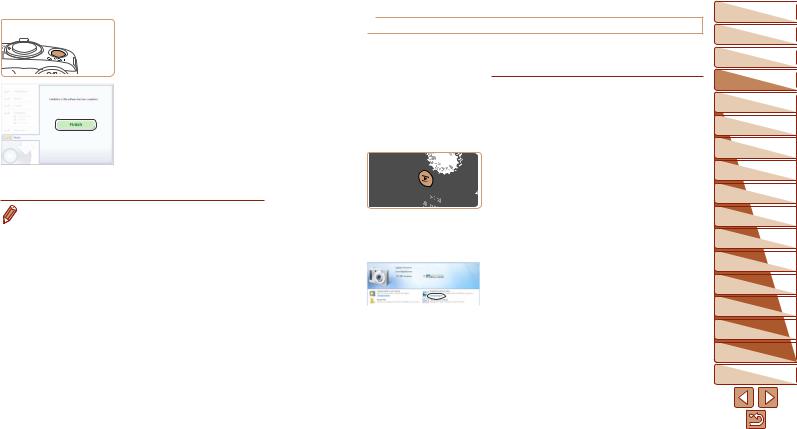
4 Install the files.
zzTurn the camera on, and follow the on-screen instructions to complete the installation process.
XXThe software will connect to the Internet to update to the latest version and download new functions. Installation may take some time, depending on computer performance and the Internet connection.
zzClick [Finish] or [Restart] on the screen after installation.
zzTurn the camera off and disconnect the cable.
• Using the software, you can update to the latest version, and download new functions via the Internet (some software excluded).
•The first time you connect the camera to the computer, drivers will be installed, so it may take a few minutes until camera images are accessible.
•Because the content and functions of software vary according to the camera model, if you have several cameras, you must use each camera to update to its latest version of the software.
 Saving Images to a Computer
Saving Images to a Computer
Windows 7 and Mac OS X 10.6 are used here for the sake of illustration. For other functions, refer to the help system of the relevant software (some software excluded).
1Connect the camera to the computer.
zzFollow step 3 in “Installing the Software” (=27) to connect the camera to a computer.
2 Turn the camera on to access CameraWindow.
zzPress the <1> button to turn the camera on.
zzOn a Macintosh computer, CameraWindow is displayed when a connection is established between the camera and computer.
zzFor Windows, follow the steps introduced below.
zzIn the screen that displays, click the [ ] link to modify the program.
] link to modify the program.
Cover
Preliminary Notes
and Legal Information
Contents: Basic
Operations
Basic Guide
Advanced Guide
1 |
Camera Basics |
2 |
Using GPS |
Function |
|
3 |
Auto Mode/ |
Hybrid Auto Mode |
|
4 |
Other Shooting |
Modes |
|
5 P Mode |
|
6 |
ModeTv, Av, and M |
7 |
Playback Mode |
8 |
Wi-Fi Functions |
9 |
Setting Menu |
10 |
Accessories |
11 |
Appendix |
Index
28
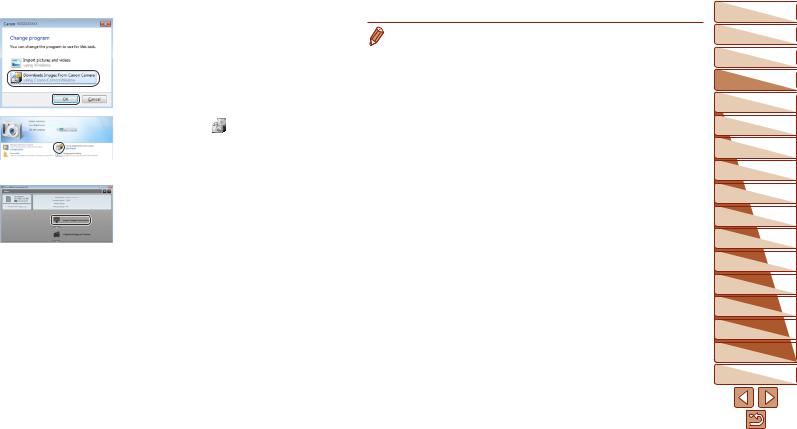
|
zzChoose [Downloads Images From Canon |
|
Camera using Canon CameraWindow] |
|
and then click [OK]. |
|
zzDouble click [ ]. |
CameraWindow |
3 Save the images to the |
|
|
|
computer. |
|
zzClick [Import Images from Camera], and |
|
then click [Import Untransferred Images]. |
|
XXImages are now saved to the Pictures |
|
folder on the computer, in separate |
|
folders named by date. |
|
zzAfter images are saved, close |
|
CameraWindow, press the <1> button |
|
to turn the camera off, and unplug the |
|
cable. |
|
zzFor instructions on viewing images on |
|
a computer, refer to the Software Guide |
|
(=26). |
•In Windows 7, if the screen in step 2 is not displayed, click the [ ] icon in the taskbar.
] icon in the taskbar.
•To start CameraWindow in Windows Vista or XP, click [Downloads Images From Canon Camera using Canon CameraWindow] on the screen displayed when you turn the camera on in step 2. If CameraWindow is not displayed, click the [Start] menu and choose [All Programs] ► [Canon Utilities] ► [CameraWindow] ► [CameraWindow].
•On a Macintosh computer, if CameraWindow is not displayed after step 2, click the [CameraWindow] icon in the Dock (the bar at the bottom of the desktop).
•Although you can save images to a computer simply by connecting your camera to the computer without using the software, the following limitations apply.
-It may take a few minutes after you connect the camera to the computer until camera images are accessible.
-Images shot in vertical orientation may be saved in horizontal orientation.
-Image protection settings may be cleared from images saved to a computer.
-Some problems may occur when saving images or image information, depending on the operating system version, the software in use, or image file sizes.
-Some functions provided by the software may not be available, such as movie editing.
Cover
Preliminary Notes
and Legal Information
Contents: Basic
Operations
Basic Guide
Advanced Guide
1 |
Camera Basics |
2 |
Using GPS |
Function |
|
3 |
Auto Mode/ |
Hybrid Auto Mode |
|
4 |
Other Shooting |
Modes |
|
5 P Mode |
|
6 |
ModeTv, Av, and M |
7 |
Playback Mode |
8 |
Wi-Fi Functions |
9 |
Setting Menu |
10 |
Accessories |
11 |
Appendix |
Index
29
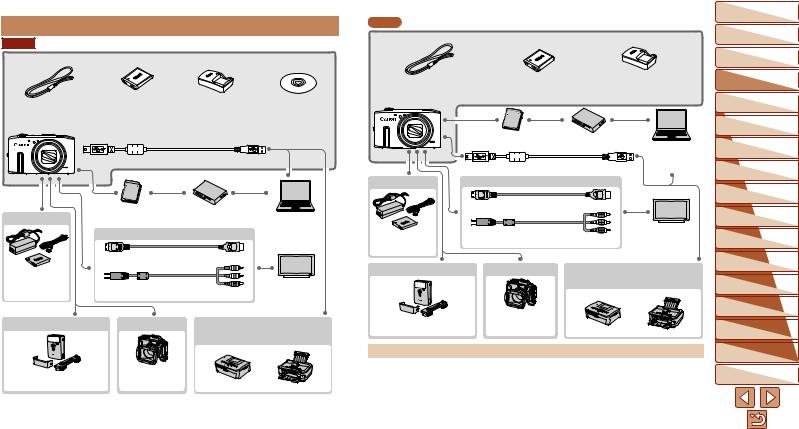
 System Map
System Map
SX280 HS
Included Accessories
Wrist Strap |
Battery Pack |
Battery Charger |
DIGITAL |
WS DC11 |
NB-6L*1 |
CB-2LY/CB-2LYE*1 |
CAMERA |
|
|
|
Solution Disk |
|
Interface Cable IFC-400PCU*1 |
|
|
Power |
Memory Card |
Card Reader |
Windows/ |
|
|
||
|
Cables |
Macintosh |
|
|
Computer |
||
|
|
|
|
|
HDMI Cable HTC-100 |
|
|
AC Adapter Kit |
|
|
TV/Video |
ACK-DC40 |
Stereo AV Cable AVC-DC400ST |
||
|
System |
||
Flash Unit |
Case |
Canon-brand PictBridge- |
|
|
|
Compatible Printers |
|
High-Power Flash |
Waterproof Case |
|
|
WP-DC49 |
|
|
|
HF DC2*2 |
|
|
|
*1 Also available for purchase separately.
*2 High-Power Flash HF-DC1 also supported.
*3 A genuine Canon accessory is also available (Interface Cable IFC-400PCU).
SX270 HS
Included Accessories |
|
|
|
|
Wrist Strap |
Battery Pack |
Battery Charger |
||
WS DC11 |
NB-6L*1 |
CB-2LY/CB-2LYE*1 |
||
|
Memory Card |
Card Reader |
Windows/ |
|
|
|
|
||
|
|
|
Macintosh |
|
|
USB Cable (camera end: Mini-B)*3 |
Computer |
||
Power |
Cables |
|
|
|
|
HDMI Cable HTC-100 |
|
||
AC Adapter Kit |
|
|
TV/Video |
|
Stereo AV Cable AVC-DC400ST |
System |
|||
ACK-DC40 |
||||
|
|
|
||
Flash Unit |
Case |
Canon-brand PictBridge- |
||
|
|
Compatible Printers |
||
High-Power Flash |
Waterproof Case |
|
WP-DC49 |
||
HF DC2*2 |
||
|
Use of genuine Canon accessories is recommended.
This product is designed to achieve excellent performance when used with genuine Canon accessories.
Canon shall not be liable for any damage to this product and/or accidents such as fire, etc., caused by the malfunction of non-genuine Canon accessories (e.g., a leakage and/or explosion of a battery pack). Please note that this warranty does not apply to repairs arising out of the malfunction of non-genuine Canon accessories, although you may request such repairs on a chargeable basis.
Note that availability varies by area, and some accessories may no longer be available.
Cover
Preliminary Notes
and Legal Information
Contents: Basic
Operations
Basic Guide
Advanced Guide
1 |
Camera Basics |
2 |
Using GPS |
Function |
|
3 |
Auto Mode/ |
Hybrid Auto Mode |
|
4 |
Other Shooting |
Modes |
|
5 P Mode |
|
6 |
ModeTv, Av, and M |
7 |
Playback Mode |
8 |
Wi-Fi Functions |
9 |
Setting Menu |
10 |
Accessories |
11 |
Appendix |
Index
30
